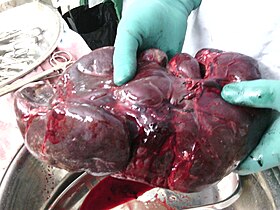Splenectomy
This article needs additional citations for verification. (August 2016) |
| Splenectomy | |
|---|---|
 Surgically removed spleen of a child with thalassemia. It is about 15 times larger than normal. | |
| ICD-9-CM | 41.43, 41.5 |
| MeSH | D013156 |
| OPS-301 code | 5-413 |
A splenectomy is the surgical procedure that partially or completely removes the spleen. The spleen is an important organ in regard to immunological function due to its ability to efficiently destroy encapsulated bacteria. Therefore, removal of the spleen runs the risk of overwhelming post-splenectomy infection, a medical emergency and rapidly fatal disease caused by the inability of the body's immune system to properly fight infection following splenectomy or asplenia.[1]
Common indications for splenectomy include trauma, tumors, splenomegaly or for hematological disease such as sickle cell anemia or thalassemia.[2]
Indications
The spleen is an organ located in the
It is removed under the following circumstances:
- When it becomes very large such that it becomes destructive to platelets/red blood cells or rupture is imminent
- For diagnosing certain lymphomas
- Certain cases of splenic abscess
- Certain cases of wandering spleen
- Splenic vein thrombosis with bleeding Gastric varices
- When platelets are destroyed in the spleen as a result of an idiopathic thrombocytopenic purpura.
- When the spleen bleeds following physical trauma
- Following spontaneous rupture
- For long-term treatment of congenital erythropoietic porphyria (CEP) if severe hemolytic anemia develops[5]
- The spread of gastric cancer to splenic tissue
- When using the splenic artery for kidney revascularisation in renovascular hypertension.
- For long-term treatment of congenital pyruvate kinase (PK) deficiency
- Those who have a severe version of the hereditary blood disorder Spherocytosis.
- During surgical resection of a pancreatic cancer
The classical cause of traumatic damage to the spleen is a blow to the abdomen during a sporting event. In cases where the spleen is enlarged due to illness (mononucleosis), trivial activities, such as leaning over a counter or straining while defecating, can cause a rupture.
Procedure
Side effects
Splenectomy causes an increased risk of
Splenectomy also increases the severity of babesiosis, Splenectomized patients are more susceptible to contracting babesiosis and can die within five to eight days of symptom onset.[7] They have severe hemolytic anemia, and occasional hepatomegaly has been documented. Parasitemia levels can reach up to 85% in patients without spleens, compared to 1–10% in individuals with spleens and effective immune systems.[8]
An increase in blood
A splenectomy also results in a greatly diminished frequency of memory B cells.
Subtotal splenectomy
Much of the spleen's protective roles can be maintained if a small amount of spleen can be left behind.[17] Where clinically appropriate, attempts are now often made to perform either surgical subtotal (partial) splenectomy,[18] or partial splenic embolization.[19] In particular, whilst vaccination and antibiotics provide good protection against the risks of asplenia, this is not always available in poorer countries.[20] However, as it may take some time for the preserved splenic tissue to provide the full protection, it has been advised that preoperative vaccination still be given.[21]
See also
- Asplenia
- Autosplenectomy
- Overwhelming post-splenectomy infection
- Lymphatic system
- Infectious mononucleosis
- List of surgeries by type
References
- PMID 25318011.
- PMID 24316283.
- S2CID 39791978.
- ^ S2CID 30554953.
- ^ Frye R. (2006-03-02). "Porphyria, Cutaneous". eMedicine. Retrieved 2006-03-28.
- ^ PMID 23801854.
- ^ "Babesiosis". National Institute of Allergy and Infectious Diseases, National Institutes of Health. 2009-02-19. Archived from the original on 2009-03-05.
- ISBN 978-0071466332.
- PMID 8601117.
- ^ Kolata G (9 November 2004). "A Diabetes Researcher Forges Her Own Path to a Cure". The New York Times.
- Who Named It?
- S2CID 25109676.
- ^ Rodak B, Fritsma G, Doig K. Hematology: Clinical Principles and Applications.
- PMID 11681780.
- PMID 12682112.
- S2CID 38605411.
- PMID 957066.
- S2CID 22741973.
- S2CID 41343243.
- PMID 18031639.
- PMID 9660206.
